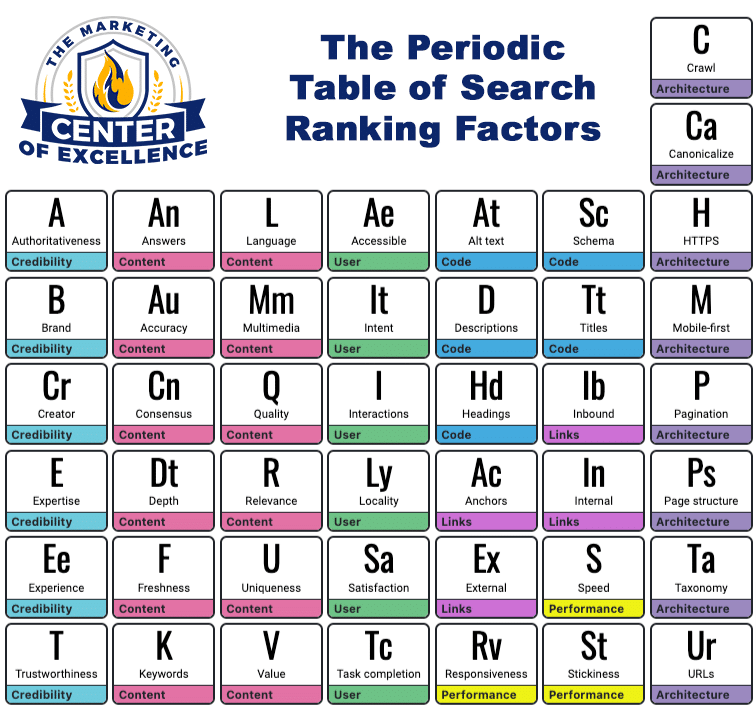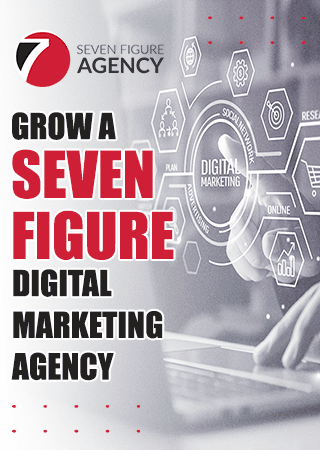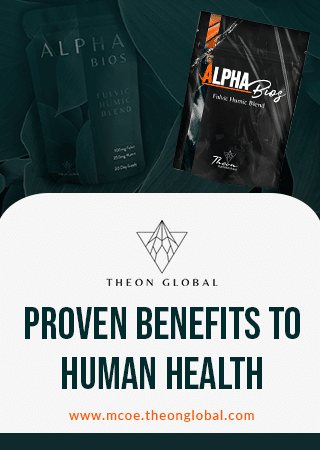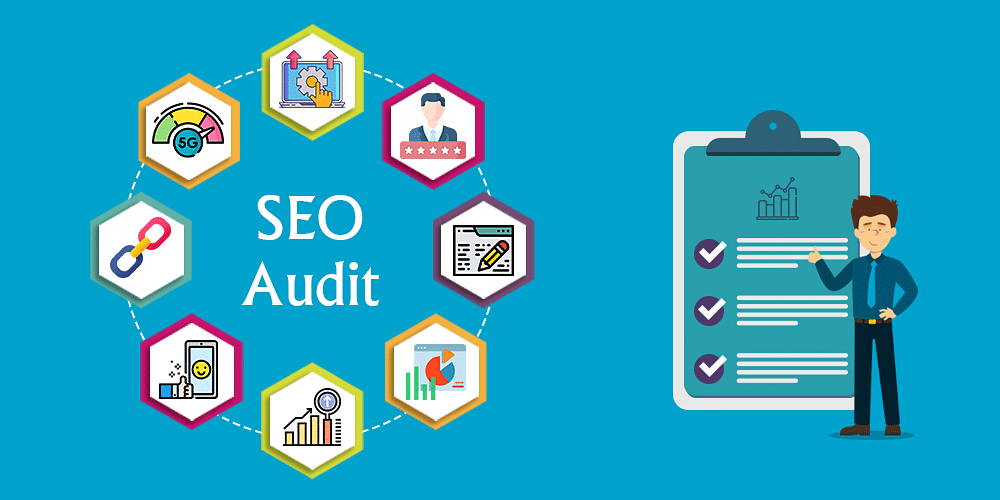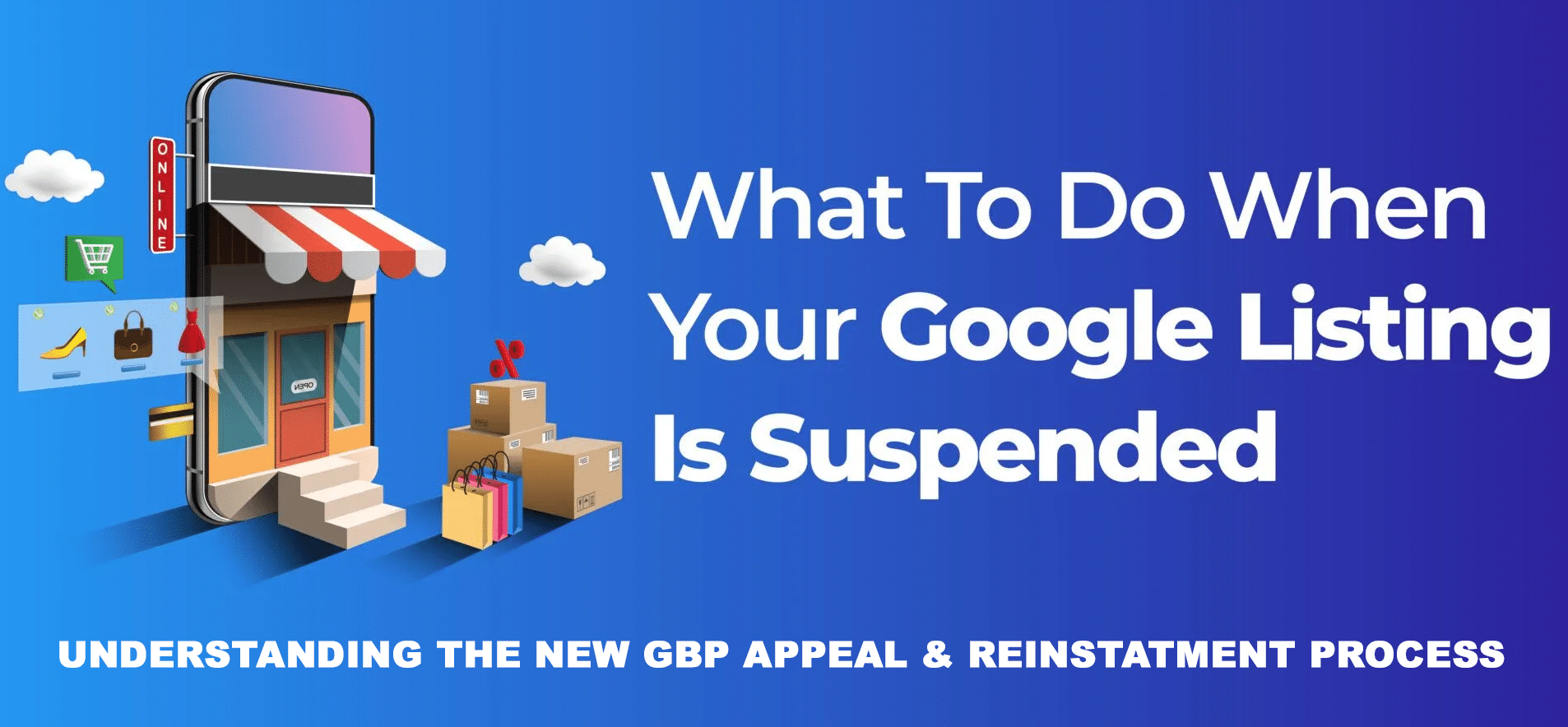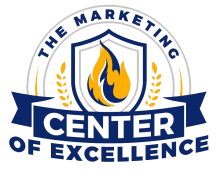Table of Contents
- 1 Mastering the SEO Ranking Factors that Matter
- 2
- 3 Content: The King of SEO
- 4
- 5 Credibility: Establishing Trust and Authority
- 6
- 7 Architecture: Structuring Your Site for Success
- 8 Code: Enhancing SEO Through Technical Excellence
- 9
- 10 Links: Building Connections
- 11
- 12 User Experience: Meeting Your Audience’s Needs
- 13 Performance: Speed and Efficiency
- 14 Local Ranking Factors for 2024
- 15 Conclusion: A Holistic Approach to SEO is the way to go
- 16 About the Author – Lane Houk
Mastering the SEO Ranking Factors that Matter
In digital marketing, SEO is a pivotal strategy for enhancing website visibility in search engine results and driving organic traffic which typically drives the highest quality, highest intent leads to any business. The Periodic Table of SEO Elements has been published by Search Engine Land since 2011 and offers a holistic view of the essential components contributing to a successful SEO strategy. I have found this table to be a helpful guide or template at a high level but in order to actually incorporate this into your SEO/web presence strategy means digging deeper below the surface and putting this into tactical elements that will be implemented across all SEO campaigns in your agency.
This new guide I have developed for 2024 delves into each of the elements or ranking factors for 2024, with a special focus and spotlight on Content and Credibility due to the evolving importance in these two areas. In this guide, my goal is to equip you with the knowledge to optimize your website and overall web presence with a comprehensive approach using a tried and tested framework for building a winning search engine optimization strategy.
Too often, I see agencies looking for a shortcut to rankings, jumping from one new tactic to another; or, wanting to over-simplify the complex process of optimizing an entity and their digital assets for search. I don’t advise this “over-simplistic” or “shiny object” approach. Instead, look to execute a holistic strategy that encompasses nearly all of what we will discuss here and look/test for the minimum viable solution you can bring to each campaign to get results predictably at least 80% of the time. Then stick with these best practices!
Ok ready? Let’s dive right in…
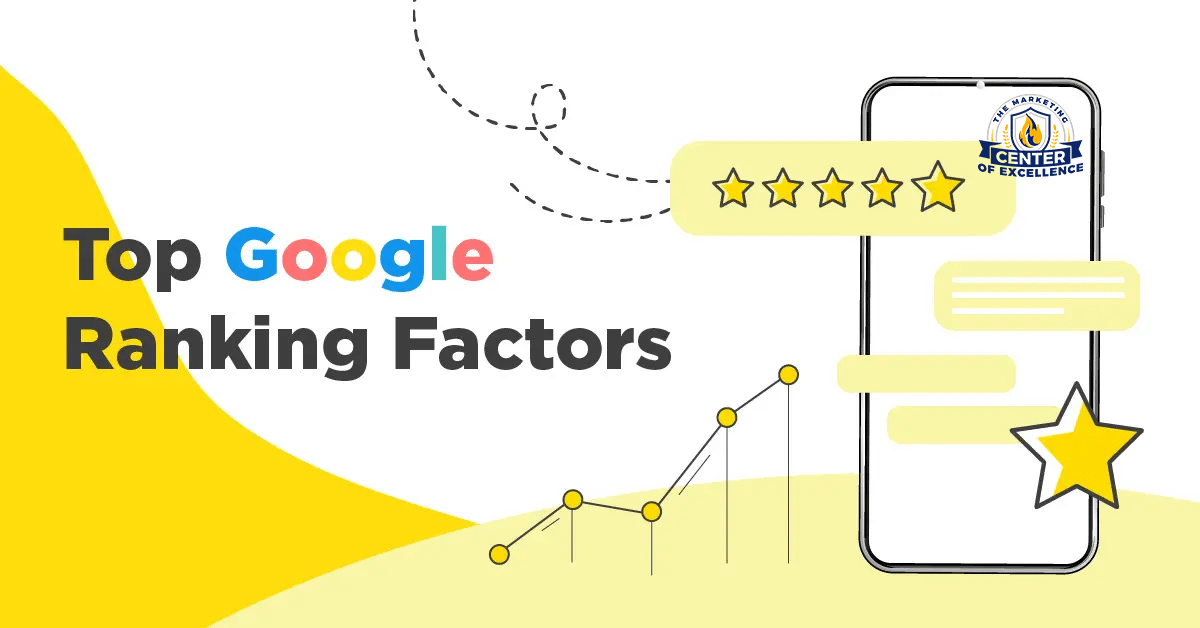
Content: The King of SEO
Content is the foundation of SEO, attracting both users and search engines with high-quality, relevant, and engaging information.
Google’s Helpful Content System is an update to Google’s search algorithm designed to prioritize and reward content that provides a satisfying, helpful experience to users. Launched to ensure that high-quality, informative content created for people, rather than search engines, ranks higher in search results, this system emphasizes the importance of user-focused content. It aims to diminish the visibility of low-quality content that prioritizes SEO tactics over user value.
The system evaluates content based on various factors that measure its helpfulness and relevance to real human interests and queries. Websites that consistently produce content designed to help and inform users are more likely to perform well under this system. Conversely, content that seems to have been primarily created to attract search engine traffic, without providing clear, direct, and useful information, may see a decline in search rankings.
It’s important to understand that this HC system is running in multiple parts of the algorithm. SEO agencies must have more than just the basics of this system baked into their content-generation/writing strategy.
Quality (Q)
High-quality content establishes your site as a trustworthy source. Strategy: Focus on addressing your audience’s pain points with well-researched and engaging content including answering PAA (people also ask) questions. Tactic: Conduct original research or interviews and publish your findings. Publish and answer new questions that the market hasn’t asked before.
Keywords (K)
Keywords make your content discoverable. Strategy: Use SEO tools like SearchAtlas.com to find relevant, high-volume keywords and entities that need to be included in your content. Tactic: Incorporate long-tail keywords AND related entities naturally in your content.
Freshness (F)
Updating content keeps it relevant. Strategy: Regularly refresh popular articles and repurpose old blog articles with new info, images, Q&A, etc. Tactic: Use a content calendar for scheduling updates to ensure the freshness signal is always on.
Relevance (R)
Content must match search intent. Strategy: Tailor content to the search intent behind keywords. Tactic: Outline main questions or tasks before writing and always include Q&A in your content with relevant questions and answers.
Depth (Dt)
Comprehensive coverage provides thorough answers. Strategy: Address related subtopics and questions. Tactic: Use “Also Asked” for related questions. Use a tool like AnswerthePublic.com or SearchAtlas.com to find commonly asked questions about a given topic.
Uniqueness (U)
Unique content stands out. Strategy: Offer new perspectives or proprietary data. Tactic: Conduct and share original research. There aren’t any shortcuts to being unique and offering fresh perspectives and topics in a given space or industry but those that put the time and effort into doing so are usually rewarded well by the algorithm.
Answers (An)
Directly answer user queries. Strategy: Structure content with question-based H2 headings. Tactic: Use H3 section heading and bullet points for easy scanning of the answer(s).
Multimedia (Mm)
Multimedia enhances engagement and Google’s algorithm loves to see Mm in content because it knows users love it. Strategy: Incorporate varied multimedia elements like relevant images/pictures and video. Tactic: Embed videos and create infographics. Use AI to do this!
Language (L)
Speak your audience’s language. Strategy: Write in a tone that resonates with your audience. Tactic: Tailor language using audience demographics and great market research tools like SearchAtlas.com to get these data points and insights that can be incorporated into your content/language strategy.
Credibility: Establishing Trust and Authority
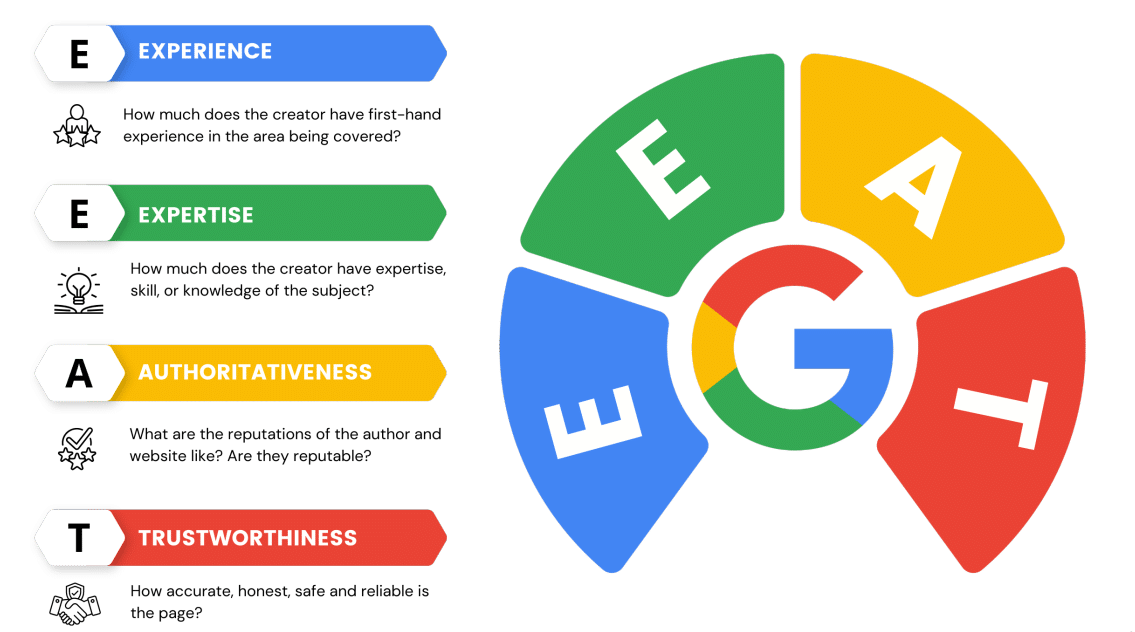
Authoritativeness (A)
Being seen as an authority boosts credibility. Strategy: Showcase expertise through in-depth content, a good author page, and a well-documented LinkedIn profile. Tactic: Leverage a sound digital PR strategy with a smart content strategy for expert positioning using press releases and authoritative news distribution.
Trustworthiness (T)
Accuracy and transparency foster trust. Strategy: Fact-check content and display clear contact information. Tactic: Add an ‘About Us’ page for the company website AND a Team page for the key employees/team members; ensure that each key employee/stakeholder has their own unique bio and author page linked from the Team page.
Brand (B)
A strong brand identity connects with audiences. Strategy: Develop a consistent brand voice. Tactic: Share behind-the-scenes content on social media. Use digital PR to build brand mentions regularly.
Experience (Ee)
Personal experiences demonstrate expertise. Strategy: Share case studies and success stories. Tactic: Publish detailed case studies, education, certifications, licenses, continuing education, and other examples that document experience in an industry or subject matter. Push these updates everywhere… LinkedIn, blog, social media, etc
Architecture: Structuring Your Site for Success
A well-structured website enhances user experience and search engine indexing. This component is highly underrated and misunderstood by many to most. Do not overlook this section. These signals are critical to success in the SERPS and have become more influential in the last 1-2 years than ever before.
Crawl (C)
Making your site easily crawlable improves visibility. Strategy: Use a logical site silo structure. See the taxonomy section below. Tactic: Audit your site for crawl errors and fix them. Use schema on every page to assist the crawler in identifying what the content is about.
Mobile-first (M)
Mobile optimization is essential. Strategy: Design with mobile users in mind. Tactic: Check mobile usability with Google’s tool. Simple but many fail to do this basic stuff.
URLs (Ur)
Clear URLs reflect the content. Strategy: Create descriptive URLs with keywords. Tactic: Use blog categories in your permalink structure and use hyphens to separate words in URLs.
Pagination (P)
Proper pagination aids navigation. Strategy: Implement pagination correctly. Tactic: Use rel=”next” and rel=”prev” tags.
Page Structure (Ps)
Logical content organization improves SEO. Strategy: Use headings (H2, H3, H4, etc) to structure articles. Tactic: Incorporate keywords and PAA in headings. Use long tail keywords in headings.
Taxonomy (Ta)
Clear categorization helps users find content. The element of taxonomy in website structure plays a pivotal role in organizing content in a manner or method that enhances both user experience and SEO because it enhances site/page crawl-ability. A well-thought-out taxonomy system categorizes and connects content, making it easier for users to find related information and for search engines to understand the relationships between different pieces of content. Here, we’ll dive deeper into the importance of taxonomy, its impact on SEO, and practical strategies for implementing an effective taxonomy system on your website.
Understanding Taxonomy in Website Structure
Taxonomy, in the context of a website, refers to the classification system used to organize content into categories and subcategories. This hierarchical structure helps in grouping content by topic, making navigation intuitive for users and content discovery more efficient for search engines. I call this “Silo Structure” in a website so if you’ve heard me use that term before, we are talking about site taxonomy and structure.
The Importance of Taxonomy for User Experience
A clear and logical taxonomy improves the user experience by:
- Reducing Complexity: By categorizing content, users can easily navigate through the site and find the information they need without feeling overwhelmed.
- Enhancing Discoverability: A well-structured taxonomy helps users discover related content, encouraging them to spend more time on the site.
- Improving Navigation: It serves as a roadmap for users, guiding them through different sections of the site seamlessly allowing the user to “dive into various silos” of the site quickly based on their search intent.
The Impact of Taxonomy on SEO
From an SEO perspective, a well-defined taxonomy:
- Boosts Site Structure: Search engines favor websites with a clear structure. A logical taxonomy/silo structure helps search engines understand your site’s hierarchy, improving indexing.
- Enhances Keyword Optimization: Categories and subcategories allow for targeted keyword optimization, increasing the chances of ranking for specific topics.
- Facilitates Internal Linking: Taxonomy creates natural opportunities for internal linking, distributing page authority throughout the site and improving SEO.
Strategies for Implementing an Effective Taxonomy
- Understand Your Audience: Before creating a taxonomy, research your audience’s needs and how they search for information. This understanding will guide the creation of categories that resonate with your users.
- Analyze Your Content: Review your existing content to identify common themes and topics. This analysis will form the basis of your primary categories.
- Create a Hierarchical Structure: Design a hierarchy starting with broad categories that narrow down into more specific subcategories. Ensure that this structure is logical and scalable, allowing for future content expansion.
- Use Optimized Category Names: Choose category and subcategory names that are based on the primary or top-level seed keywords. Keep the number of categories to a minimum using only top-level keywords (shortest possible) which are usually only one to two words. You can use sub-categories for further definition in your hierarchy if desired but be cautious and don’t go crazy creating tons of categories or sub-categories.
- Keep It Balanced: Aim for a balanced distribution of content across categories. Avoid having too many categories with too little content or a few categories overloaded with content.
- Implement Breadcrumbs: Breadcrumbs are navigational aids that show users their current location within the site’s taxonomy. They enhance user experience and reinforce the site’s structure to search engines.
- Regularly Review and Adjust: As your site grows, regularly review your taxonomy to ensure it still accurately reflects your content. Be prepared to adjust categories and structure to accommodate new topics or shifts in user interest.
- Implement a table of contents for your blog articles: Having a table of contents further improves taxonomy at the page/post level and helps both reader and bot quickly understand the content and link to specific spots in the content that are of interest. TOC is only effective with proper use of section headings.
Strategy: Use a clear taxonomy that is derived from good market/keyword/entity research using SearchAtlas.com. Tactic: Limit categories and use tags sparingly. Only top-level seed keywords should be used for categories. All blog articles should be assigned to the most relevant category and be sure to use Authorship when publishing blog articles.
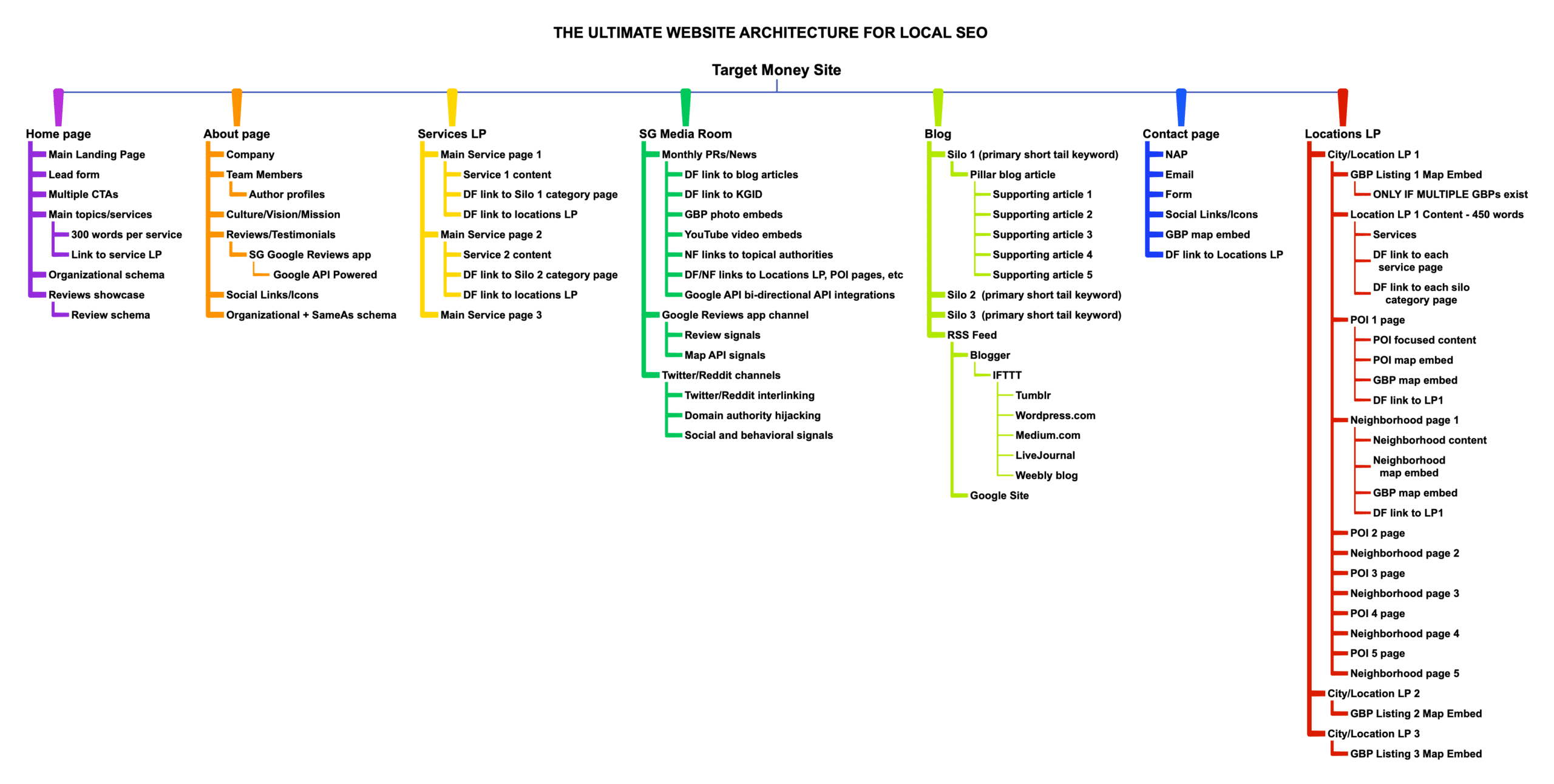
Code: Enhancing SEO Through Technical Excellence
Optimizing your site’s code enhances performance and visibility. This is probably pretty obvious as much as it is straightforward to implement. Use AI to assist you in creating these code-level signals in your pages and posts.
Titles (Tt)
Descriptive titles attract clicks. Strategy: Write unique titles with primary keywords. Tactic: Keep titles under 60 characters. Make sure your page/post titles are different!
Descriptions (D)
Meta descriptions act as ad copy. Strategy: Craft compelling descriptions leveraging AI. Tactic: Include a call to action, always! Don’t use the same description across all pages.
Headings (Hd)
Headings organize content. Strategy: Use headings for structure. Tactic: Include secondary keywords, long tails, and PAA in subheadings. Be sure to mark them up with H2-H5 appropriately.
Alt Text (At)
Alt text improves image SEO. Strategy: Provide descriptive alt text. Tactic: Describe the image and include keywords. So many people overlook this signal and it is a signal that Googlebot always gets when crawling a page (if you have it).
Schema (Sc)
Schema markup enhances SERPs because it gives Googlebot highly specific instructions about the nature of the content on a page. Strategy: Use schema for detailed information. Tactic: Implement schema for reviews, articles, and products. If it’s a local business, add local business schema to the home page, contact page plus any location pages.
Links: Building Connections
Links establish your site’s authority and help with navigation. Use a SaaS service like Signal Genesys to build links and connections in a leveraged, economical way before you put time and money into manual link building or purchasing expensive links. 
Inbound (Ib)
Quality inbound links boost authority. Strategy: Create shareable content. Tactic: Promote content through outreach. Create a blog-sharing network amongst peers.
Internal (In)
Internal links improve engagement. Strategy: Use internal linking wisely. Tactic: Link to important pages with descriptive anchor text. Only link to other relevant pages with internal links. There are tools and plugins that also help with this process.
External (Ex)
Linking out adds value. Strategy: Link to reputable, authoritative sources. Tactic: Regularly update external links. Use authoritative sources when implementing external links. Why link to a spammy or non-authority site? You’re making connections so remember this when developing external links for greater context and depth for the reader (and the bot).
User Experience: Meeting Your Audience’s Needs
User experience influences how visitors interact with your site.
Accessibility (Ae)
An accessible site reaches more users. Strategy: Follow WCAG guidelines. Tactic: Ensure keyboard navigability and use high-contrast colors. Use a tool like Accessibe to aid in bringing a website into a basic level of accessibility compliance.
Intent (It)
Content should match user intent. Strategy: Align content with search intent. Tactic: Analyze SERPs for intent clues. Again, SearchAtlas.com is an awesome tool for discovering search intent and mapping that into your content strategy.
Satisfaction (Sa)
Satisfying content keeps users on your site. Strategy: Fully address user queries. Answer the questions the market is asking! Tactic: Include clear calls to action.
Performance: Speed and Efficiency
Site performance affects user experience and rankings.
Speed (S)
Fast loading times are crucial. Strategy: Optimize images and use browser caching. Tactic: Use Google PageSpeed Insights for optimization tips. Be careful of too many scripts running, pixels installed, excessive plugins installed, or large images. These are common culprits in slow-loading sites. Use WPRocket Pro if it’s a WordPress site for caching and performance tweaks that are quantifiable. We use it on all sites.
Responsiveness (Rv)
A responsive site is essential. Strategy: Ensure optimal viewing on all devices. Tactic: Use responsive design techniques.
Implementing these strategies and tactics for each element of the Periodic Table of SEO Elements will comprehensively enhance your website’s SEO, making it more visible, engaging, and authoritative. Remember, SEO is an ongoing process that requires continuous learning and adaptation to the latest trends and algorithm updates.
Stickiness (St)
Create an engaging website that makes people want to spend time on it and come back. Essentially, dwell time is the KPI to measure this element and CRO (conversion rate optimization) is the tactic to apply to a site to improve Stickiness.
Local Ranking Factors for 2024
One critical area that SEL’s table of elements lacks is a category for the local ranking factors that move the needle in the map pack results or are otherwise important to pay attention to within your overall SEO/web presence strategy. This is a critical area because map pack results actually drive the most and best or highest-intent leads to a local business so failure to include these elements will result in less than desirable outcomes so be sure to include these elements for local rankings.
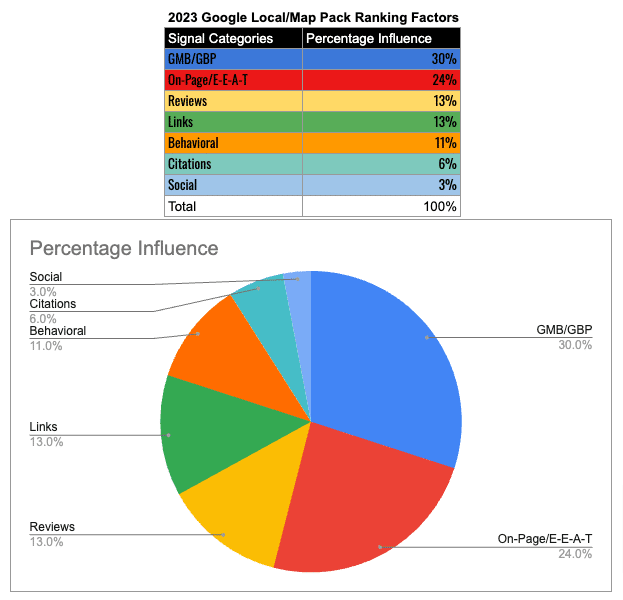
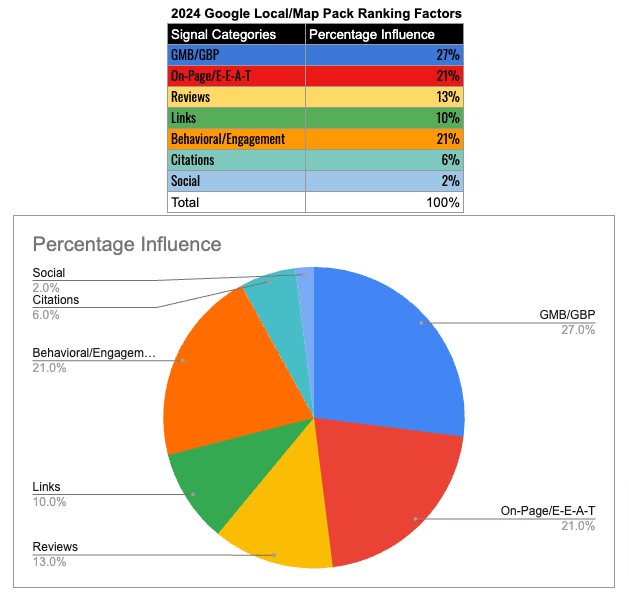
These 2 pie charts illustrate the percentage of influence of the major elements involved in local search rankings and they are different based on the last 2 years (2023 and 2024). As you can see, there is some crossover with elements like links and on-page elements but the biggest area of influence in the local algorithm is the GBP listing category, on-page/EEAT, and now behavioral/engagement for 2024. In this category, there are scores of opportunities to communicate to the public and the algorithm what the business is all about.
I want to point out what’s changed in my opinion over the last 2 years with the biggest change in the behavioral/engagement category. I am seeing engagement signals drive real rankings meaning engagement signals are real ranking factors. What does engagement mean? People clicking on your GBP posts or photos, new reviews, searchers clicking on your listing vs a competitor and dwelling for a minute or two on your GBP listing or blog article, users sharing your articles, people using the Google Maps app to lookup your GBP listing, get directions and actually drive to the GBP listing location (can’t be a service area business obviously). These are all examples of engagement signals that are quite meaningful.
Elements of Google’s Local Algorithm
Google’s local algorithm plays a crucial role in determining how businesses rank in local search results or map pack results, which are super-important for companies serving specific geographic areas. This algorithm considers various factors to provide users with the most relevant local results based on their queries. Understanding these factors can help businesses optimize their online presence to rank higher in local search results and attract more customers. Here’s a summary of the key factors that influence Google’s local algorithm:
1. Relevance
Relevance refers to how well a local business profile matches what users are searching for. Google evaluates the information in a business’s profile, including descriptions, category selections, and services offered, to determine its relevance to specific search queries. To improve relevance, businesses should ensure their Google My Business (GMB) profiles are complete, accurate, and detailed.
2. Proximity
Proximity is the distance between the searcher and the business locations listed in the search results. Google aims to provide the most accessible options based on the user’s location or the geographic terms used in their search query. While businesses can’t change their physical location to improve rankings, they can optimize for specific local keywords that potential customers might use.
3. Prominence
Prominence relates to how well-known or popular a business is, both online and offline. Google considers several factors to determine prominence, including:
- Links: The number and quality of backlinks pointing to the business’s website.
- Reviews: The quantity, quality, and frequency of reviews on the GMB profile and other review sites.
- Local Content: The presence of local keywords and content on the business’s website that match search queries.
- SEO Factors: Traditional SEO factors like on-page optimization, domain authority, and social media presence also play a role.
4. Google My Business Optimization
A well-optimized GMB profile is crucial for local SEO. This includes:
- Accurate and complete business information (name, address, phone number).
- Choosing the right business categories.
- Posting regular updates and offers.
- Encouraging customers to leave positive reviews and responding to reviews.
5. User Engagement
Google also considers how users interact with a business’s listing, including click-through rates, direction requests, and check-ins. Engaging content and offers can increase user interaction with your listing.
6. Behavioral Signals
Behavioral signals, such as click-through rates (CTR) from search results to a website and the time spent on a site, can indicate the relevance and attractiveness of a business to potential customers. Optimizing website content and user experience can improve these signals.
7. Social Signals
While the direct impact of social signals on Google’s local algorithm is debated, a strong social media presence can enhance a business’s overall online visibility and contribute to its perceived prominence. The most benefit of social signals will come in the form of referral traffic and clicks from social posts as long as you are including a link in your social posts to a relevant page, blog article or press release on the target website. Don’t forget to do this with all social posts!
Ranking well in Google’s local search results requires a multifaceted approach that includes optimizing your Google My Business profile, ensuring your website is locally optimized, building a strong backlink profile, generating positive reviews, and engaging with customers online. By focusing on these key factors, businesses can improve their visibility in local search results, attract more local customers, and outperform their competition in the digital landscape.
Conclusion: A Holistic Approach to SEO is the way to go
SEO is a complex field that requires a comprehensive approach, balancing technical optimization with high-quality content and credible information. By understanding and applying the elements of the Periodic Table of SEO Elements, you can create a robust SEO strategy that enhances your website’s visibility, engages your audience, and builds trust with both users and search engines. Remember, SEO is a continuous process of improvement and adaptation to the ever-changing digital landscape. I hope you have found this guide helpful in understanding how to implement a holistic approach to your SEO strategy!
About the Author – Lane Houk
Lane Houk spent nine (9) years building a digital marketing agency helping business clients get the recognition they deserve with an optimized web presence, greater online visibility and helping them become the number one choice amongst competitors in their local market area using proprietary brand conquesting and strategic positioning strategies. I have specific authority and expertise in Search Engine Optimization (SEO) strategies, the Google Ecosystem and am also a Level 7 Local Guide. Since 2019, I have been dedicated to working exclusively with marketers and digital agency owners as a white label partner through my two companies, Signal Genesys and Quantum Agency, and through my podcast and educational platform, The Marketing Center of Excellence (www.themarketingcoe.com).
Signal Genesys is an Adaptive Web Presence SaaS™ that leverages digital PR, content syndication, and proprietary signal generation strategies in a cloud-based platform built exclusively for digital agencies and marketers to leverage for themselves and their clients to build authority and web presence which in turn has a positive impact on search rankings.
Quantum Agency is a white-label fulfillment agency partner for agencies that want to outsource their website, SEO, and PPC fulfillment operations to a quality, dependable WL partner.
>>> Voted as one of Florida’s top business leaders by Gulf Shore Business in 2008, Lane Houk is the Founder and Managing Partner of Quantum Agency and Co-Founder of Signal Genesys.
>>> Lane received the Distinguished Leadership Award from the Community Leadership Association in 2008.
>>> Lane is also a frequent guest speaker and podcast guest in the digital marketing industry on topics like SEO, marketing technology and marketing systems that agencies can leverage in their own agency.


